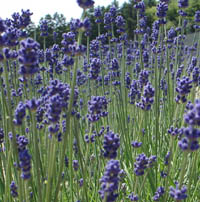|
| Lavender |

|
| Lavandula |

|
Scientific Name: Lavandula officinalis.(Synonyms : Lavandula angustifolia Miller or Lavandula vera D.C.). There are various
species of Lavender. Genuine Lavender (L. Angustifolia) alone counts many clones and breeds. Aspic (L. Latifolia) is more
sensitive to cold weather. Maritime Lavender (L. Stoechas), much different from the two preceding varieties, prefers siliceous
soils, and blossoms in the spring rather than in the summer. Lavandines are sterile hybrids of Genuine Lavender and Aspic.
Family :IACEAE (Labiées). It is originated from France, Spain and Italy. The several varieties of Lavandula Officinalis
grows wild in the south of France, in Italy, Corsica and Yugoslavia. It is cultivated widely all over the world. It does
well in chalky soils, outback. It blooms from Spring or summer depending on the species.
The extract is achieved by steam distillation or extraction of the flowers. Odor is fresh, herbaceous, and lavender.
Lavender is widely used in men's fragrances as fern notes.
Some perfumes incorporating lavender
|

